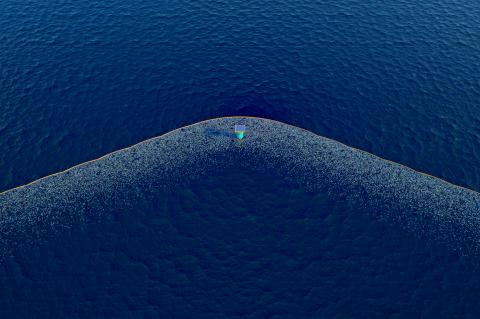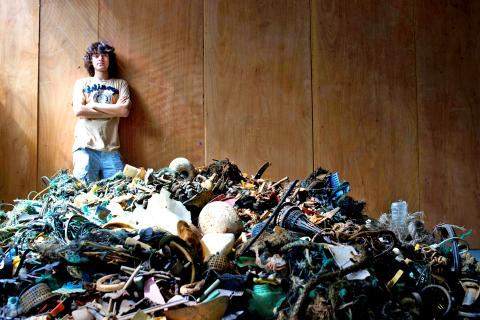Dutch student Boyan Slat is only 19 years old, but he already has 100 people working on his revolutionary plan to scoop thousands of tonnes of damaging plastics from the oceans.
The world’s “plastic soup,” much of it swirling around in five main gyres or rotating oceanic currents, costs billions of euros to the fishing and tourism sectors every year.
Estimates differ as to how much of the waste is in our oceans, ranging from half a million to millions of tonnes.

Photo: AFP
The scourge kills marine life, entering the food chain when sea creatures ingest it, as well as ensnaring dolphins and whales.
While most ideas for attacking the plastic plague involve boats criss-crossing the oceans to scoop up the waste, Slat came up with a remarkably practical way to help solve the problem: harnessing the power of sea currents to trap the “soup.”
“Why go after the plastic if the plastic can come to you?” the aeronautical engineering student told AFP.

Photo: AFP
‘SOUP TRAP’
His design calls for two vast floating arms, 50 km long each, in the form of a “V”, anchored to the ocean floor.
Curtains, ironically made from super-strong plastic, hang from the arms, dangling around three meters below the surface.
Ocean currents will force the waste into the “V” and to a cylindrical platform 11 meters in diameter floating at the end which can store up to 3,000 cubic meters of plastic (more than an Olympic swimming pool ) for eventual collection by a ship. A solar-powered conveyor belt will take the largest chunks of plastic to and from a shredder so that it will fit in the cylinder.
The blue-eyed, shaggy-haired Slat, who still lives at home with his parents, says he got his idea while scuba-diving in Greece. “I saw more plastics than fish under the water,” he recalled.
He publicly presented it for the first time at the end of 2012, hardly daring to dream it would become reality. Today, he has put his studies on hold and 100 people around the world are working for him, several of them full time.
‘FASTER, CHEAPER’
Following a year of feasibility studies and a certain amount of criticism from a skeptical scientific community, Slat wants to set up a pilot project to run for the next three or four years before installing the first operational “Ocean Cleanup Array” in the north Pacific Ocean.
He has set up a crowdfunding Web site to collect US$2 million in 100 days. He reached the first million after 32 days.
Over a 10-year period, he hopes his invention will collect nearly half of the plastic swirling around in the north Pacific Ocean.
Slat claims his method would be thousands of times faster than sending ships to fish the plastic out of the water.
“It’s not only faster, it’s also cheaper,” he said.
Around 70 people, including oceanographers, engineers and legal advisers, took part in the feasibility study, looking at legal and material questions, as well as the project’s weather-resistance and cost.
‘UNANSWERED QUESTIONS’
“The ocean cleanup team has addressed concerns that the ocean community has voiced, but there are still issues that need to be addressed,” Kim Martini, an oceanographer at Washington State University in Seattle, told AFP by e-mail.
Some say the feasibility study underestimates the proportion of micro-plastics, which are just millimeters in size and extremely difficult to trap and remove.
Others say the project itself will become a dangerous obstacle for marine life and sea traffic.
“Boyan is a terrific engineer, and we appreciate a lot what he does for the plastic soup issue,” said Anna Cummins of the 5 Gyres environmental charity and lobby group in a telephone interview.
“But what we do not understand, is why he wants to use his device so far from the coastlines,” she told AFP.
“Collecting waste from the middle of the ocean is like collecting water from a tap that is always on,” said Daniel Poolen of the Plastic Soup Foundation.
“You have to go to river mouths, to the source” of the pollution, he said.
Slat insists that the feasibility study, which concluded that the project was “likely feasible,” dealt with all the technical problems.
Nevertheless, he is aware of the limitations.
“Thankfully, I’m surrounded by people who have more knowledge than me, they bring their experience on board,” Slat said, adding: “I’m only 19!”
“Even if I think that my project is more efficient and cheaper, I know it won’t remove all plastic waste,” he admits.
“And most importantly, I know full well that the source of plastic in the oceans won’t disappear tomorrow, people will unfortunately continue to put plastic waste into the environment.”

That US assistance was a model for Taiwan’s spectacular development success was early recognized by policymakers and analysts. In a report to the US Congress for the fiscal year 1962, former President John F. Kennedy noted Taiwan’s “rapid economic growth,” was “producing a substantial net gain in living.” Kennedy had a stake in Taiwan’s achievements and the US’ official development assistance (ODA) in general: In September 1961, his entreaty to make the 1960s a “decade of development,” and an accompanying proposal for dedicated legislation to this end, had been formalized by congressional passage of the Foreign Assistance Act. Two

March 31 to April 6 On May 13, 1950, National Taiwan University Hospital otolaryngologist Su You-peng (蘇友鵬) was summoned to the director’s office. He thought someone had complained about him practicing the violin at night, but when he entered the room, he knew something was terribly wrong. He saw several burly men who appeared to be government secret agents, and three other resident doctors: internist Hsu Chiang (許強), dermatologist Hu Pao-chen (胡寶珍) and ophthalmologist Hu Hsin-lin (胡鑫麟). They were handcuffed, herded onto two jeeps and taken to the Secrecy Bureau (保密局) for questioning. Su was still in his doctor’s robes at

Last week the Democratic Progressive Party (DPP) said that the budget cuts voted for by the China-aligned parties in the legislature, are intended to force the DPP to hike electricity rates. The public would then blame it for the rate hike. It’s fairly clear that the first part of that is correct. Slashing the budget of state-run Taiwan Power Co (Taipower, 台電) is a move intended to cause discontent with the DPP when electricity rates go up. Taipower’s debt, NT$422.9 billion (US$12.78 billion), is one of the numerous permanent crises created by the nation’s construction-industrial state and the developmentalist mentality it

Experts say that the devastating earthquake in Myanmar on Friday was likely the strongest to hit the country in decades, with disaster modeling suggesting thousands could be dead. Automatic assessments from the US Geological Survey (USGS) said the shallow 7.7-magnitude quake northwest of the central Myanmar city of Sagaing triggered a red alert for shaking-related fatalities and economic losses. “High casualties and extensive damage are probable and the disaster is likely widespread,” it said, locating the epicentre near the central Myanmar city of Mandalay, home to more than a million people. Myanmar’s ruling junta said on Saturday morning that the number killed had